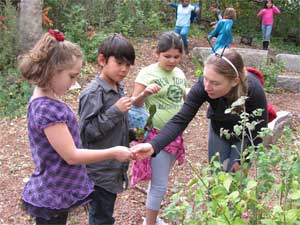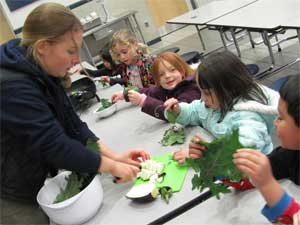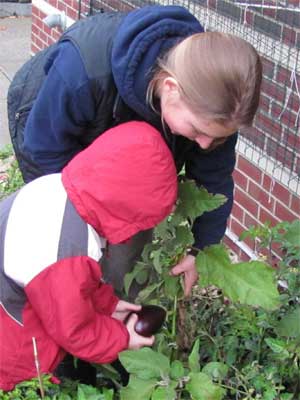
Melanie Demattia, Kung Choyang and Yenifer Velasquez (left to right) sample herbs in the Healey School garden, with Gardens Coordinator Tai Dinnan. - Photo by Elizabeth Sheeran
Somerville school gardens sow the seeds of smarter food choices
By Elizabeth Sheeran
At lunchtime recess on a sunny fall day, the Arthur D. Healey schoolyard is swarming with third and fourth graders playing ball, tag, or just hanging out. Off to one side, a few kids pick leaves off an interesting-looking plant, and each takes a nibble.
Time to call Poison Control? No, they’re just getting a taste of the licorice-flavored herb anise hyssop in the Healey School garden, under the watchful eye of School Gardens Coordinator Tai Dinnan.
Thanks to the schoolyard gardens program, many Somerville students won’t simply be thankful for the feast on the table this Thanksgiving. They’ll also have a healthy appreciation for where it came from.
“It’s about exposing students to the wide array of produce that’s out there, to participate in growing it so they place a higher value on it,” said Dinnan. “If you have students take part in every step of the process, in planting the seeds and taking care of them, and producing something that you can eat, they’re going to see and perceive vegetables in a very different way.”

Melanie Demattia, Kung Choyang and Yenifer Velasquez (left to right) sample herbs in the Healey School garden, with Gardens Coordinator Tai Dinnan. - Photo by Elizabeth Sheeran
Dinnan works for Groundwork Somerville, the local non-profit that maintains outdoor growing spaces at each of the city’s eight public and charter elementary schools and offers year-round garden-related education. Each school has an after-school garden club, and Groundwork teams up with parents to supervise gardens during recess and to host school-day activities like the occasional “tasting event.”
Somerville’s first schoolyard gardens were created in 2003 with a private foundation grant, as part of a citywide project to improve community health. Today, Groundwork manages the program with a mix of fundraising, fee-based after-school and vacation activities, and parent and community support.
Supporters say the gardens can do a lot of great things:
They serve as living laboratories teaching the life-cycle of plants and insects. They help kids connect with nature during the school day by offering a green space in schoolyards that are otherwise a sea of pavement. And they encourage students to value locally-grown produce, especially at Thanksgiving, when so many traditional dishes use ingredients grown right here in New England.
But one of the most visible things they do is to change kids’ attitudes about food, especially vegetables.
“The student who found the eggplant in the garden and got to pick it, obviously, he wants to eat it, because he picked it and he found it,” said Dinnan. “Whereas, if he were at a restaurant and was picking between eggplant and a hamburger and fries, he’d probably go for the hamburger and fries.”
Parents who volunteer at the gardens say they see it first-hand. “All of the kids become more vested in the food when they’re involved in growing it and preparing it,” said Jessica Hicks, who got connected with the Kennedy School garden when her twin sons began kindergarten this fall.
And parent volunteers say kids will sample things at school they won’t try at home. “I have friends who say their kids ‘would never taste that.’

Jonathan Peddle finds an eggplant at the Argenziano garden, assisted by Tai Dinnan. - Photo by Elizabeth Sheeran
Then we do a harvest event and they’ll taste things right there,” said Jen Capuano, whose sons are in first and fourth grade at the Healey School. “All I see is kids out there, trying things that they’ve never tried before.”
Jamal Halawa recently discovered just that when he arrived to pick up his five-year-old daughter Zia from the Argenziano after-school program. “I was very surprised to see her eating those tomatoes,” said Halawa. “Usually, she’s not eating tomatoes at home. That doesn’t happen.”
“I would never try them but now I tried them,” said Zia.
Of course, not every child will be magically transformed into a veggie-lover overnight. Hicks said one of her sons is still a hold-out, but the school garden has opened the door a little further. “Seeing the seed-to-table life cycle of the plant is making him more interested,” said Hicks.
Advocates say the measure of progress is one day at a time and one child at a time.
On a recent afternoon at the Argenziano School, a small group of students used child-sized scissors to harvest kale from the school garden. Back inside the school cafeteria, they added the kale leaves to the stir-fry being cooked up by Dinnan, along with an eggplant discovered in the garden by first-grader Jonathan Peddle, and a touch of garlic grown at the Healey School.
When the time came to sample their culinary creation, kindergartner Maya Jaugust didn’t hesitate to give it a try. When asked why she likes to eat the food grown in the garden, she offered up a ringing endorsement for locally-grown fresh food. “It tastes better… because you eat it right away.”
And then she uttered four words that are music to the ears of any parent who has ever struggled to get children to eat their vegetables: “Can I have more?”












Reader Comments